2016 年广西民族大学翻译硕士英语考研真题 A 卷
Part I. Basic English Knowledge (30%)
Section A: Multiple-choice (20 %)
Directions:Therearefortymultiple-choicequestionsinthissection.Choosethe
best answer to each question. Write your answers on the Answer Sheet.
1. On my way to the office, I saw a little girl standing in front of the shop window
looking
_____ at the toys inside.
A. faintly
B. ferociously
C. deliberately
D. wistfully
2. Sometimes the student may be asked to write about his _____ to a certain book
or article that has some bearing on the subject being studied.
A. reaction
B. comment
C. impression
D. comprehension
3. The branches could hardly _____ the weight of the fruit.
A. retain
B. sustain
C. maintain
D. remain
4. With an eighty-hour week and little change or enjoyment, life must have been
very _____
for the 19th-century worker.
A. disinterested
B. dry
C. weary
D. depressed
5. The need for cash is forcing new graduates to take any job going, and many start
their working life in _____, often menial jobs.
A. momentary
B. mechanical
C. ashamed
D. primeval
6. The bus became _____ before they arrived, and many latecomers had to wait in
a long queue.
A. occupied
B. engaged
C. packed
D. filled
7. Rosa was such a last-minute worker that she could never start writing a paper
till the deadline was_____.
A. approach
B. recent
C. problematic
D. imminent
8. Swarms of wasps are always invading my garden. They are a thorough ______.
A. nuisance
B. disturbance
C. trouble
D. annoyance
9. The new airport will be ______ from all directions.
A. available
B. accessible
C. obtainable
D. achievable
10. Now researchers are directing more attention to the social and cultural_____
�
that propelled university graduates into careers in management.
A. implication
B. impulse
C. atmosphere
D. imminence
11. The police have offered a large ____ for information leading to the robber’
s arrest.
A. award
B. compensation
C. prize
D. reward
12. For years she suffered from the _____ that her husband might come back to her.
A. vision
B. idea
C. imagination
D. illusion
13. There has been a _____ lack of communication between the union and the
management.
A. regretful
B. regrettable
C. regretting
D. regretted
14. Care should be taken to decrease the length of time that one is _____ loud
continuous noise.
A. subjected to
C. associated with
B. filled with
D. attached to
15. My mother can’t get _____ because she has rheumatism.
A. about
B. on
C. through
D. in
16. The novel contains some marvelously revealing _____ of rural life in the 19th
century.
A. glances
B. glimpses
C. glares
D. gleams
17. The party’s reduced vote was _____ of lack of support for its policies.
A. indicative
B. positive
C. revealing
D. evident
18. At three thousand feet, wide plains begin to appear, and there is never a moment
when some distant mountain is not _____.
A. on view
B. at a glance
C. on the scene
D. in sight
19. Once a picture is proved to be a forgery, it becomes quite _____.
A. invaluable
B. priceless
C. unworthy
D. worthless
20. In the first few months of the war his army seemed ______, but soon it met its
Waterloo.
A. incredible
B. invisible
C. invidious
D. invincible
21. _____ that they may eventually reduce the amount of labor needed on construction
sites by 90 percent.
A. So clever are the construction robots
B. So clever the construction robots are
�
C. Such construction robots are clever
D. Such clever construction robots are
22. He felt ______ during the interview. And he failed to get the job.
A. anything but well
C. something but well
B. nothing but well
D. none but well
23. It is not uncommon for there _____ problems of communication between the old
and the young.
A .being
B. would be
C. be
D. to be
24. _____, I’ll marry him all the same.
A. Was he rich or poor
C. Were he rich or poor
B. Whether rich or poor
D. Be he rich or poor
25. Sorry to have kept you waiting. You must have thought ______.
A. we were not coming
C. we didn’t come
B. we are not coming
D. we should not come
26. That was not the first time he _____ us. I think it’s high time we _____ strong
actions against him.
A. betrayed, take
C. has betrayed, took
B. had betrayed, took
D. has betrayed, take
27. ______, he is ready to accept suggestions from different sources.
A. Instead of his contributions
C. His making notable contributions
B. For all his notable contributions
D. However his notable contributions
28. I am pleased with what you have given me and _____ you have told me.
A. that
B. all that
C. which
D. about whatever
29. ______ earlier, I could have done something to help.
A. If I was informed
C. Had I been informed
B. Was I informed
D. If I should be informed
30. _____,he never alters a decision.
A. Come what may
C. May what come
B. What may come
D. May come whatever
31. The Minister of Finance is believed
revenue.
of imposing new taxes to raise extra
A. that he is thinking
C. that he is to think
B. to be thinking
D. to think
�
32. The heart is
by the brain.
A. not so
intelligent than the stomach, for they are both controlled
B. not much
C. no more
D. much more
33. The membership card entitled him _____ certain privileges in the club.
A. on
B. in
C. at
D. to
34. I have never been to London, but that is the city_____.
A. where I like to visit most
C. which I like to visit mostly
B. I’d most like to visit
D. where I’d like most to visit
35. He was ______to tell the truth even to his closest friend.
A. too much of a coward
C. a coward enough
B. too much the coward
D. enough of a coward
36. ______ wool that is produced in _____ Scotland is used to make sweaters and
other garments.
A. / ... the
B. / ... /
C. The ... the
D. The ... /
37. _____ I like economics, I like sociology much better.
A. As much as
B. So much
C. How much
D. Much as
38. You cannot be ______ careful in making the decision as it was such a critical
case.
A. too
B. quite
C. very
D. so
39. _____ enough time and money, the researchers would have been able to discover
more in this field.
A. Giving
B. To give
C. Given
D. Being given
40. Barry had an advantage over his mother
he could speak French.
A. since that
B. in that
C. at that
D. so that
Section B:
Proofreading and Error Correction (10 %)
Directions: The following passage contains 10 errors. Each indicated line
containsamaximumofONEerror.Ineachcase,onlyONEwordisinvolved.Youshould
proofreadthepassageandcorrectit.PleasewriteyouranswersontheAnswerSheet.
People once widely believed that intelligent life existed on
Mars. The 19th century discover of what appeared to be
geometric designs cut across the surface was taken as evidence.
The lines were thought to have been system of canals that had
been built to irrigate the surface. This is now clear that
“canals”—perhaps the most spectacular geologic features of
41.
42.
43.
�
Mars—are natural valleys which ancient rivers once flowed.
Other fragmented idea concerns the planet’s seasonal
changes in color. Once when attributed to the rapid spread of
some life-form, these shifts are now known to develop from the
movement of fine dust in the atmosphere.
By the close of the 20th century none of the many
experiments were conducted by spacecraft had ever found
persuasive evidence of life. Furthermore, speculation continued
over the existence of some form of life, in either the present
and the past. In 1996 scientists discovered organic compounds
and minerals in a meteorite, consisted of Martian rock,
that collided with Earth around 11,000 BC. These compounds
suggest that Mars may have been inhabited by organisms more
than three billion years ago.
44.
45.
46.
47.
48.
49.
50.
Part II.
Section A (30 %)
Reading Comprehension (50 %)
Directions:Thereare3passagesinthissection.Eachpassageisfollowedby
some questions or unfinished statements. For each of them there are four choices
markedA),B),C)andD).Youshoulddecideonthebestchoiceandwriteyouranswers
on the Answer Sheet.
Passage One
Questions 51 to 55 are based on the following passage.
Department Store Magic
For most of the 20th century Smithson's was one of Britain's most successful
department stores, but by the mid-1990s, it had become dull. Still profitable,
thanks largely to a series of successful advertising campaigns, but decidedly boring.
The famous were careful not to be seen there, and its sales staff didn't seem to
have changed since the store opened in 1908. Worst of all, its customers were buying
fewer and fewer of its own-brand products, the major part of its business, and
showing a preference for more fashionable brands.
But now all this has changed, thanks to Rowena Baker, who became Smithson's
first woman Chief Executive three years ago. Since then, while most major retailers
in Britain have been losing money, Smithson's profits have been rising steadily.
When Baker started, a lot of improvements had just been made to the building, without
having any effect on sales, and she took the bold decision to invite one of Europe's
most exciting interior designers to develop the fashion area, the heart of the store.
This very quickly led to rising sales, even before the goods on display were changed.
And as sales grew, so did profits.
Baker had ambitious plans for the store from the start. ‘We're playing a big
game, to prove we're up there with the leaders in our sector, and we have to make
sure people get that message. Smithson's had fallen behind the competition. It
provided a traditional service targeted at middle-aged, middle-income customers,
�
who'd been shopping there for years, and the customer base was gradually contracting.
Our idea is to sell such an exciting variety of goods that everyone will want to
come in, whether they plan to spend a little or a lot.' Baker's vision for the store
is clear, but achieving it is far from simple. At first, many employees resisted
her improvements because they just wouldn't be persuaded that there was anything
wrong with the way they'd always done things, even if they accepted that the store
had to overtake its competitors. It took many long meetings, involving the entire
workforce, to win their support. It helped when they realized that Baker was a very
different kind of manager from the ones they had known.
Baker's staff policies contained more surprises. The uniform that had hardly
changed since day one has now disappeared. Moreover, teenagers now get young shop
assistants, and staffs in the sports departments are themselves sports fans in
trainers. As Baker explains, ‘How can you sell jeans if you're wearing a black
suit? Smithson's has a new identity, and this needs to be made clear to the
customers.' She's also given every sales assistant responsibility for ensuring
customer satisfaction, even if it means occasionally breaking company rules in the
hope that this will help company profits.
Rowena Baker is proving successful, but the City's big investors haven't been
persuaded. According to retail analyst, John Matthews, ‘Money had already been
invested in refurbishment of the store and in fact that led to the boost in sales.
She took the credit, but hadn't done anything to achieve it. And in my view the
company's shareholders are not convinced. The fact is that unless she opens several
more stores pretty soon, Smithson's profits will start to fall because turnover
at the existing store will inevitably start to decline.'
51. According to the writer, in the mid-1990s Smithson's department store
A. was making a loss.
B. had a problem keeping staff.
C. was unhappy with its advertising agency.
D. mostly sold goods under the Smithson's name.
52. According to the writer, Smithson's profits started rising three years ago
because of
A. an improvement in the retailing sector.
B. the previous work done on the store.
C. Rowena Baker's choice of designer.
D. a change in the products on sale.
53. According to Rowena Baker, one problem which Smithson's faced when she joined
was that
A. the number of people using the store was falling slowly.
B. its competitors offered a more specialized range of products.
�
C. the store's prices were set at the wrong level.
D. customers were unhappy with the service provided.
54. According to the writer, many staff opposed Baker's plans because
A. they were unwilling to change their way of working.
B. they disagreed with her goals for the store.
C. they felt they were not consulted enough about the changes.
D. they were unhappy with her style of management.
55. Baker has changed staff policies because she believes that
A. the corporate image can be improved through staff uniforms.
B. the previous rules were not fair to customers.
C. customers should be able to identify with the staff serving them.
D. employees should share in company profits.
Passage Two
Questions 56 to 60 are based on the following passage.
The Affect of Electricity on Cancer
Can electricity cause cancer? In a society that literally runs on electric power,
the very idea seems preposterous. But for more than a decade, a growing band of
scientists and journalists has pointed to studies that seem to link exposure to
electromagnetic fields with increased risk of leukemia and other malignancies. The
implications are unsettling, to say the least, since everyone comes into contact
with such fields, which are generated by everything electrical, from power lines
and antennas to personal computers and micro-wave ovens. Because evidence on the
subject is inconclusive and often contradictory, it has been hard to decide whether
concern about the health effects of electricity is legitimate—or the worst kind
of paranoia.
Now the alarmists have gained some qualified support from the U.S. Environmental
Protection Agency. In the executive summary of a new scientific review, released
in draft form late last week, the EPA has put forward what amounts to the most serious
government warning to date. The agency tentatively concludes that scientific
evidence “suggests a causal link” between extremely low-frequency electromagnetic
fields—those having very long wave-lengths—and leukemia, lymphoma and brain
cancer, While the report falls short of classifying ELF fields as probable
carcinogens, it does identify the common 60-hertz magnetic field as “a possible,
but not proven, cause of cancer in humans.”
The report is no reason to panic—or even to lost sleep. If there is a cancer
risk, it is a small one. The evidence is still so controversial that the draft stirred
a great deal of debate within the Bush Administration, and the EPA released it over
strong objections from the Pentagon and the White House. But now no one can deny
that the issue must be taken seriously and that much more research is needed.
At the heart of the debate is a simple and well-understood physical phenomenon:
When an electric current passes through a wire, it generates an electromagnetic
�
field that exerts forces on surrounding objects, For many years, scientists
dismissed any suggestion that such forces might be harmful, primarily because they
are so extraordinarily weak. The ELF magnetic field generated by a video terminal
measures only a few mill gauss, or about one-hundredth the strength of the earth’
s own magnetic field, The electric fields surrounding a power line can be as high
as 10 kilovolts per meter, but the corresponding field induced in human cells will
be only about 1 mill volt per meter. This is far less than the electric fields that
the cells themselves generate.
How could such minuscule forces pose a health danger? The consensus used to
be that they could not, and for decades scientists concentrated on more powerful
kinds of radiation, like X-rays, that pack sufficient wallop to knock electrons
out of the molecules that make up the human body. Such “ionizing” radiations have
been clearly linked to increased cancer risks and there are regulations to control
emissions.
But epidemiological studies, which find statistical associations between sets
of data, do not prove cause and effect. Though there is a body of laboratory work
showing that exposure to ELF fields can have biological effects on animal tissues,
a mechanism by which those effects could lead to cancerous growths has never been
found.
The Pentagon is for from persuaded. In a blistering 33-page critique of the
EPA report, Air Force scientists charge its authors with having “biased the entire
document” toward proving a link. “Our reviewers are convinced that there is no
suggestion that (electromagnetic fields) present in the environment induce or
promote cancer,” the Air Force concludes. “It is astonishing that the EPA would
lend its imprimatur on this report.” Then Pentagon’s concern is understandable.
There is hardly a unit of the modern military that does not depend on the heavy
use of some kind of electronic equipment, from huge ground-based radar towers to
the defense systems built into every warship and plane.
56. The main idea of this passage is
A. studies on the cause of cancer.
B. controversial view-points in the cause of cancer.
C. the relationship between electricity and cancer.
D. different ideas about the effect of electricity on cancer.
57. The view-point of the EPA is
A. there is casual link between electricity and cancer.
B. electricity really affects cancer.
C. controversial.
D. low frequency electromagnetic field is a possible cause of cancer.
58. Why did the Pentagon and Whit House object to the release of the report?
Because
A. it may stir a great deal of debate among the Bush Administration.
�
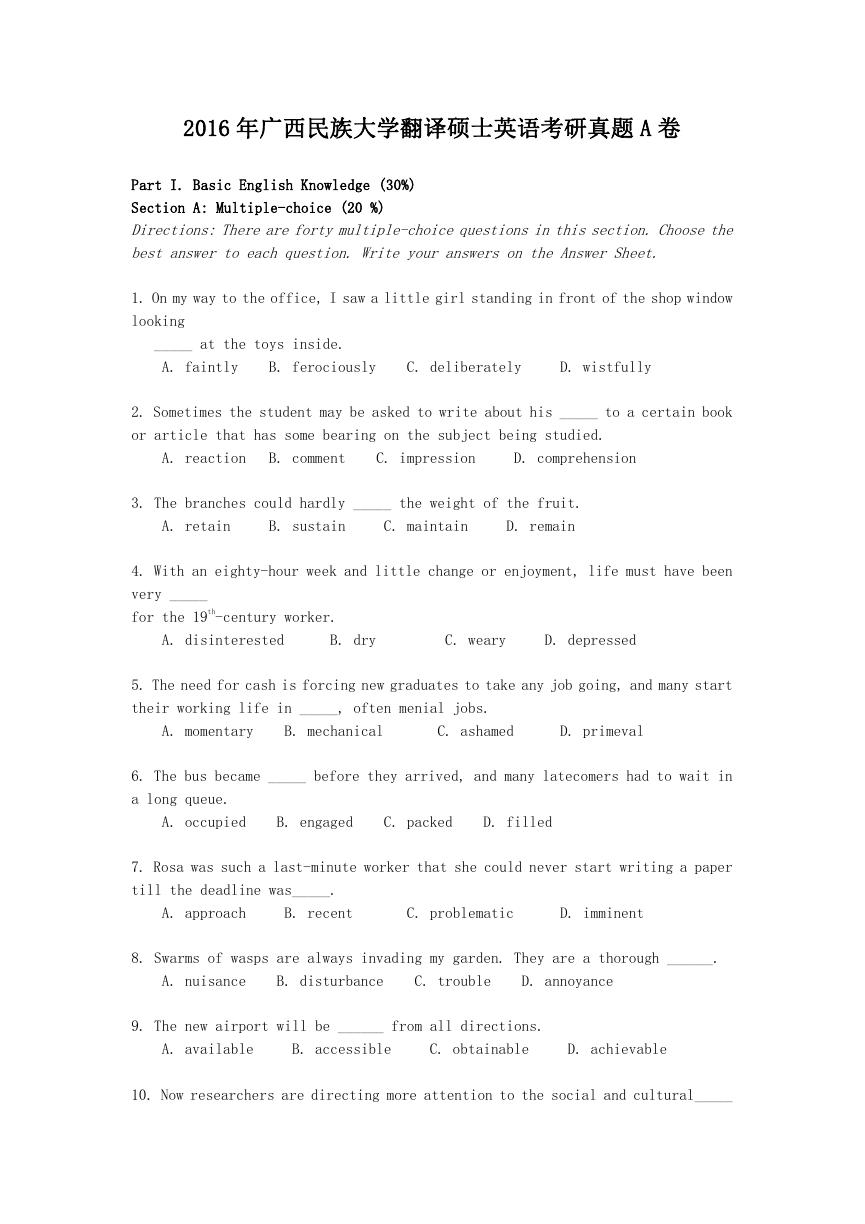

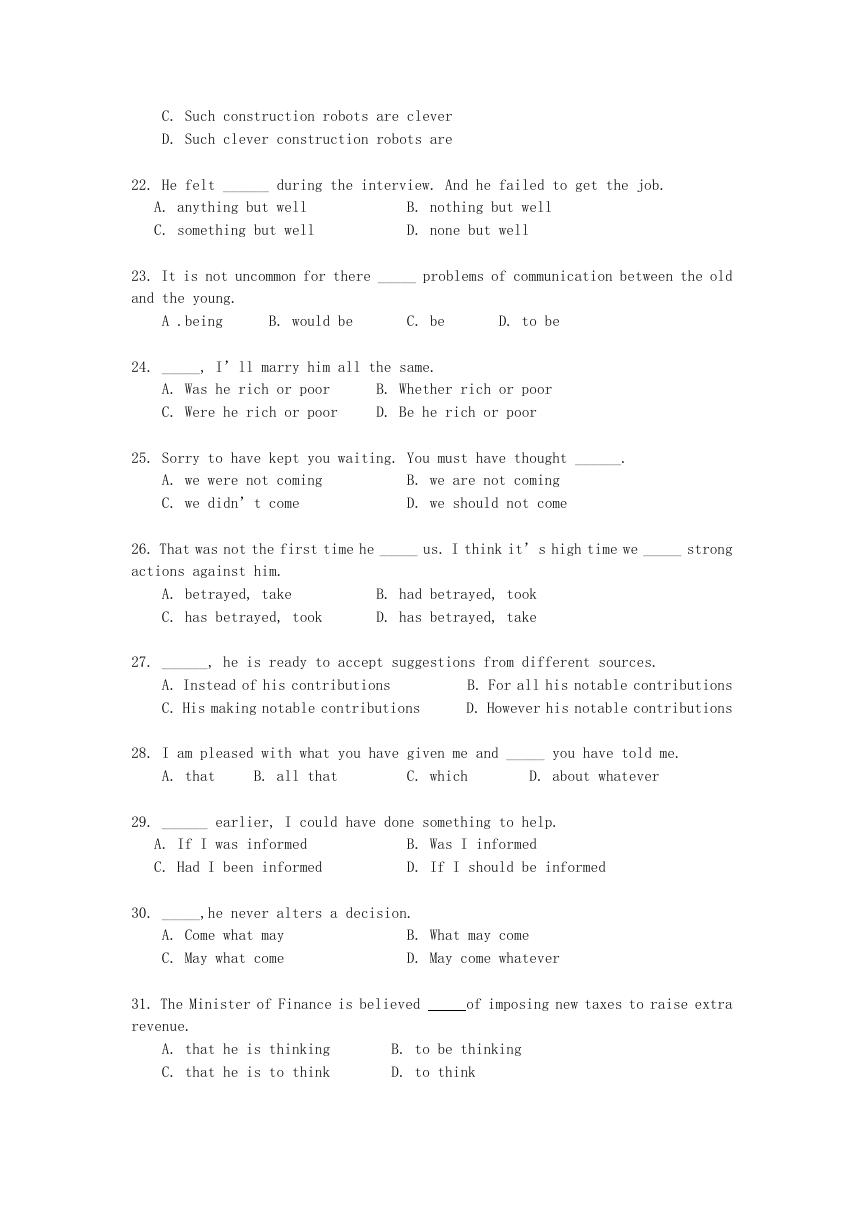
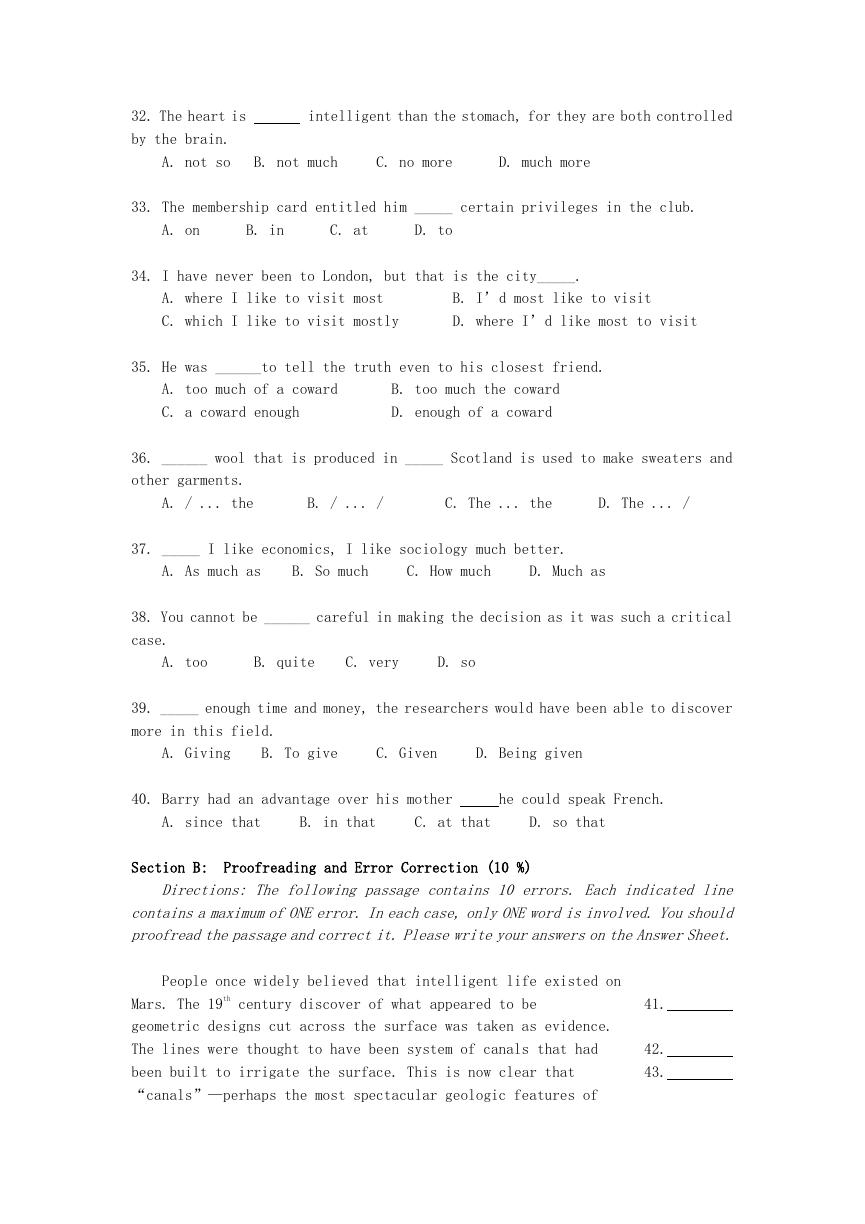

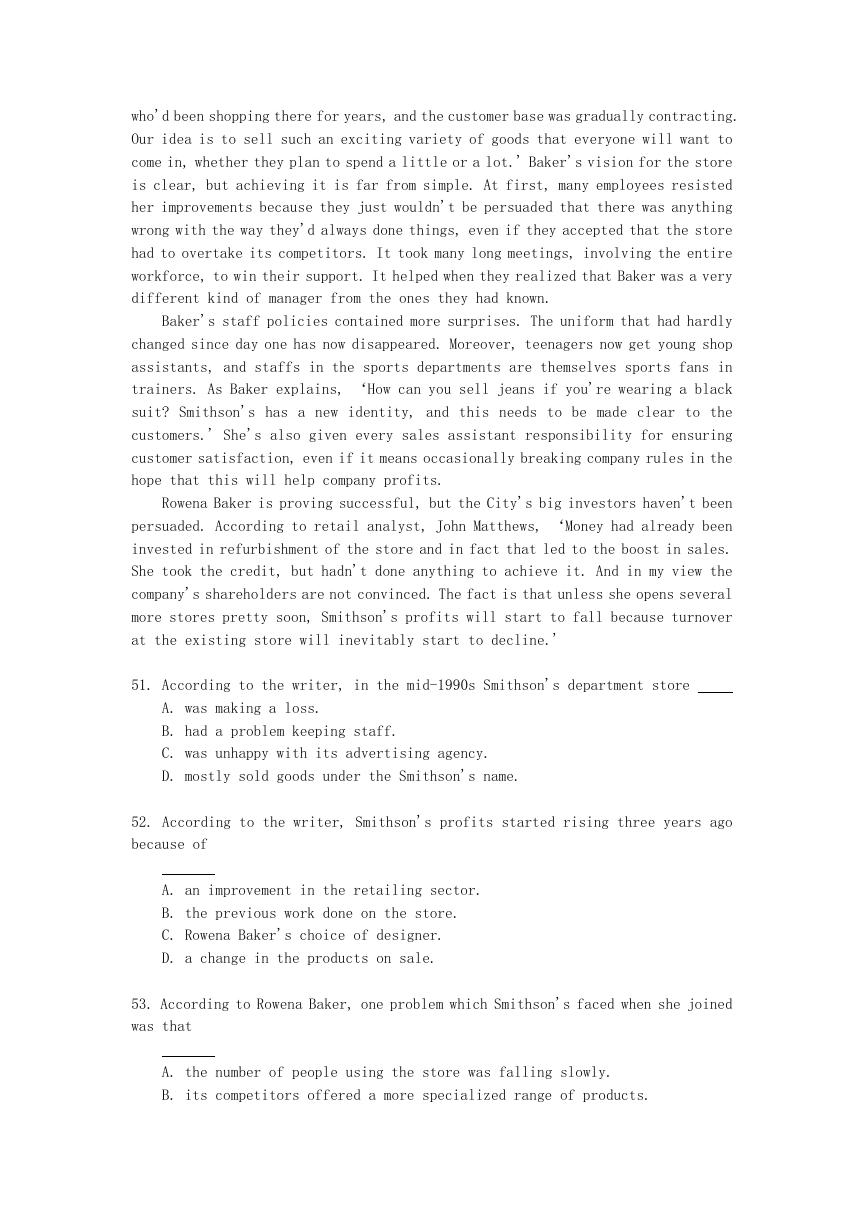
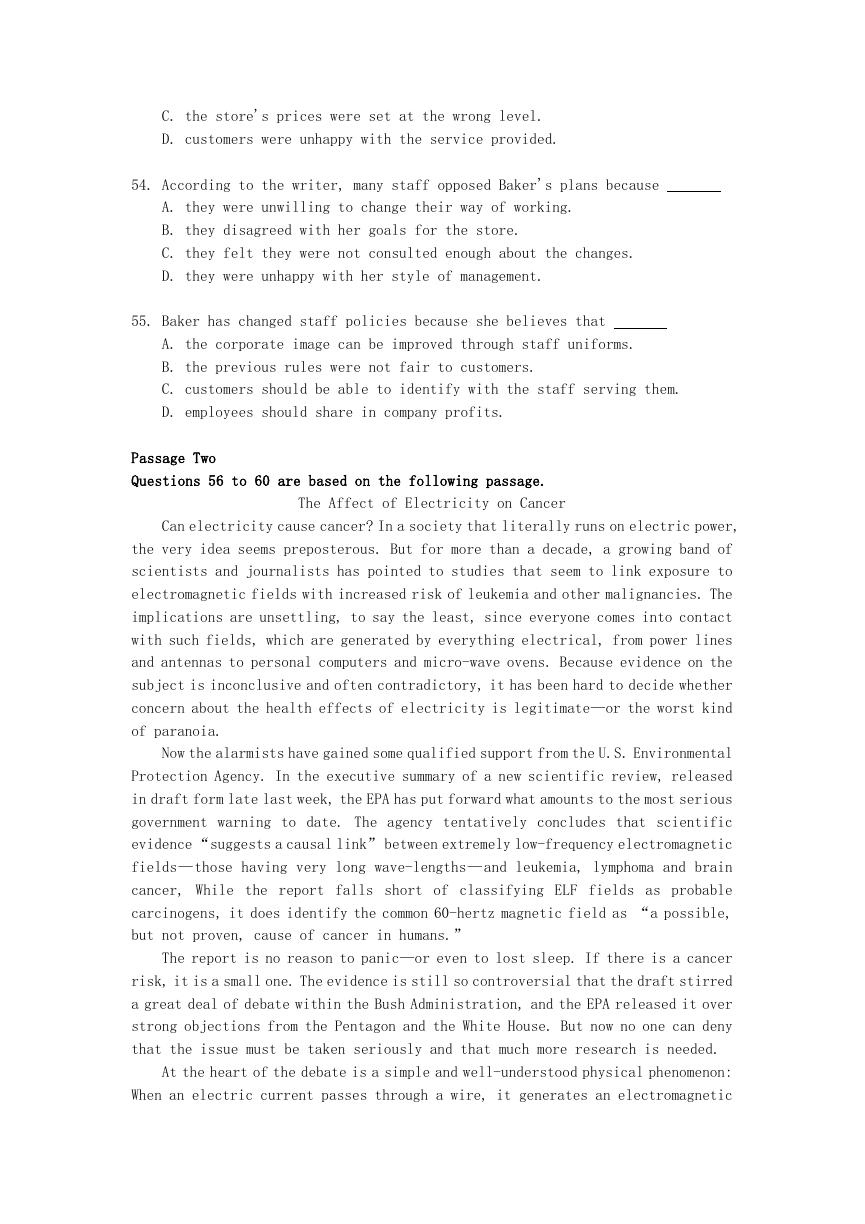









 2023年江西萍乡中考道德与法治真题及答案.doc
2023年江西萍乡中考道德与法治真题及答案.doc 2012年重庆南川中考生物真题及答案.doc
2012年重庆南川中考生物真题及答案.doc 2013年江西师范大学地理学综合及文艺理论基础考研真题.doc
2013年江西师范大学地理学综合及文艺理论基础考研真题.doc 2020年四川甘孜小升初语文真题及答案I卷.doc
2020年四川甘孜小升初语文真题及答案I卷.doc 2020年注册岩土工程师专业基础考试真题及答案.doc
2020年注册岩土工程师专业基础考试真题及答案.doc 2023-2024学年福建省厦门市九年级上学期数学月考试题及答案.doc
2023-2024学年福建省厦门市九年级上学期数学月考试题及答案.doc 2021-2022学年辽宁省沈阳市大东区九年级上学期语文期末试题及答案.doc
2021-2022学年辽宁省沈阳市大东区九年级上学期语文期末试题及答案.doc 2022-2023学年北京东城区初三第一学期物理期末试卷及答案.doc
2022-2023学年北京东城区初三第一学期物理期末试卷及答案.doc 2018上半年江西教师资格初中地理学科知识与教学能力真题及答案.doc
2018上半年江西教师资格初中地理学科知识与教学能力真题及答案.doc 2012年河北国家公务员申论考试真题及答案-省级.doc
2012年河北国家公务员申论考试真题及答案-省级.doc 2020-2021学年江苏省扬州市江都区邵樊片九年级上学期数学第一次质量检测试题及答案.doc
2020-2021学年江苏省扬州市江都区邵樊片九年级上学期数学第一次质量检测试题及答案.doc 2022下半年黑龙江教师资格证中学综合素质真题及答案.doc
2022下半年黑龙江教师资格证中学综合素质真题及答案.doc